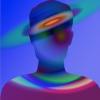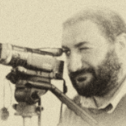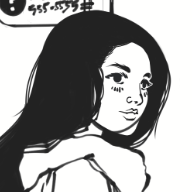-
Posts
1,887 -
Joined
Reputation Activity
-
 gdenby got a reaction from ziplock9000 in Resize multiple objects at once
gdenby got a reaction from ziplock9000 in Resize multiple objects at once
On Mac, "transform separate."
-
 gdenby got a reaction from faulknermano in Cutout Filter Workaround
gdenby got a reaction from faulknermano in Cutout Filter Workaround
Maybe add a "posterize" adjustment layer? Set blend mode to luminosity and levels to 4 or less.
-
 gdenby got a reaction from EarthBear in Drawing / Sketching help
gdenby got a reaction from EarthBear in Drawing / Sketching help
Hi, neteunnito,
Can comment on 2 items
The pencil is a vector tool. There will always be nodes using it. While being made, the line will always show the nodes. Switch to pixel personna, and use the brush tool. No nodes, but you can not change what you have done like w. a vector tool.
Using the vector brush without a stroke isn't what it is designed for. It is supposed to stretch a bitmap along the vector. You can draw w. it, and then use the fill tool tool to add a fill, and then use the stroke studio to remove the stroke. Or just use the pen tool, which is more appropriate, because it can be set to have no stroke, and only a fill.
The only way I know to save a particular pencil setting is to change the tool default, which means every time you want to use the pencil, which means you'll have to change it if you want anything different. Same difference. I'm thinking you might want to leave it at default, and after drawing, go to the stroke studio and assign whatever stroke you want to use for the current work. You will most likely want to work on making your own brushes, which can then be attached to any vector line.
-
 gdenby got a reaction from Clayton King in Affinity Designer - Search or Sort Layers
gdenby got a reaction from Clayton King in Affinity Designer - Search or Sort Layers
Yes, a good feature request. I often have hundreds of layers, and scrolling thru them can often be quite difficult. So over to features request.
-
 gdenby got a reaction from Petr Bajer in AD: Direction of stroke gradient
gdenby got a reaction from Petr Bajer in AD: Direction of stroke gradient
After defining the stroke weight, you can set the gradient in the stroke dialogue if you like. But to change its position and direction, you need to us the fill tool. Select the object, select the fill tool and change the context from "fill" to "stroke." Then adjust as desired/
-
 gdenby got a reaction from Josephmsc in Best Image Vectorizer for Mac with Affinity Designer
gdenby got a reaction from Josephmsc in Best Image Vectorizer for Mac with Affinity Designer
I use Image Vectorizer, but only rarely for scans of hand drawn work. It has a decent ability to improve contrast, sharpness, do de-speckling and set edge threshold. It also seems quick to me. For $5, it performs very well, and only adds maybe 15 seconds to getting a trace into AD.
If I need something w. multiple grey scales, I use (free) Inkscape's trace tool. Inkscape runs poorly on Macs, so I don't use it often enough to be familiar w. the more complex settings. But after thrashing about some, I can usually get very good results.
FWIW, I've been using auto tracing to start works based on old decorative motifs for years, mostly w. Corel. To this day, I haven't come across a tool that gives me results that don't require lots and lots of adjustment. Often enough, I spend more time fixing trace problems, than just re-doing w. a pen tool. W. the advent of resonabley priced tablets, for my own works, I no longer start w. scans from paper.
-

-
 gdenby got a reaction from AncientWire in How do I add an outline around the whole design?
gdenby got a reaction from AncientWire in How do I add an outline around the whole design?
I'm assuming the art is all vector work. If so, it is easy. Select all, and make a copy. Group the originals, and lock them. Paste the copies in, and while they ar highlighted, use the boolean add. Change the fill to none, and change the stroke to a white line of whatever size you might need, and have the stroke set to "align stroke to outside" in the stroke dialogue.
Outline.afdesign
-
 gdenby got a reaction from WolgAbrupt0r in [Designer] Rotate and Snap?
gdenby got a reaction from WolgAbrupt0r in [Designer] Rotate and Snap?
Hi, Igull,
Don't worry about the annoyance. Lots of people trying to move from AI to AD show that. Usually it is mostly a matter of learning new habits. I doubt Designer will ever work the same way as Illustrator. Basic differences in how the shapes are made and modified. There will disruptions in routine.
But, you a quite right. There isn't any way as far as I can tell to snap the center of rotation to guides at present.
From my experience, AD has features that AI had after 5 - 10 years. A few, well beyond that. What you describe was once nothing AI could do. Believe me, Illustrator after 10 years of admittedly ground breaking development was still not faster or easier to use than a drafting board and Letraset press ons. IMPERATIVE may have taken 30 years. If you have to have some features, at the moment it doesn't seem you have many options other than the Adobe ecosystem.
Myself, the $$$$$ are not an issue. Its the subscription model, and the apparent necessity to be connected to Adobe network.
Referring to an attributes picker, Designer does allow copying layer "styles," which are a combination of stroke and fill attributes. Those can be pasted as a style, just as easy as using the color picker.
-
 gdenby got a reaction from PaoloT in NeoFinder DAM Tool with Affinity products?
gdenby got a reaction from PaoloT in NeoFinder DAM Tool with Affinity products?
Hi, AffinityAppMan,
I've been using NeoFinder for the last 18 months, or so. Thanks to your note, I'm d-loading an upgrade right now. I've been quite happy with it. Very fast. Can search and find a few files out of several 100 thousand in a few moments. I expect it will work w. the Affinity files as it does w. every other.
Took about 30 seconds to build a catalog of of all my Affinity files, including .pdf documentations. More than 2000. Did a couple of finds, response was quick when I pointed to the new catalog.
-
 gdenby got a reaction from Andreas Scherer in Resize multiple objects at once
gdenby got a reaction from Andreas Scherer in Resize multiple objects at once
On Mac, "transform separate."
-
 gdenby got a reaction from Megnusin in Bake rotation into path
gdenby got a reaction from Megnusin in Bake rotation into path
Make a copy of the path. Add it to itself. Do a divide. That resets the box. If you have an open curve, as illustrated, that will close, and need breaking/deleting.
-
 gdenby got a reaction from soterios in Affinity Designer vs. Inkscape
gdenby got a reaction from soterios in Affinity Designer vs. Inkscape
Speaking as someone who has to run Inkscape under the XQuartz windowing system on a Mac, I'd have to say the on screen response is not good at all. And, I've read comments indicating that the XQuartz project itself may be fading, as there has been no update in about 18 months.
Inkscape has a bunch of features not found (yet) in Designer. But on the Mac side, the interface is so hard to use that over 15 years of intermittent use, I'm still often at a loss for what to do. I guess in common use, I'd have to say that Inkscape's learning curve is way higher than AD. If you already are comfortable w. Ink... and it gets the job done, sure stick with it. I keep it on my system and thrash w. it a bit often enough. But Designer, once you get the hang of it, is remarkably easy to use, and on my hardware, fast enough that there 90% of all operations are done with no lag, or ones that are at best a few seconds.
And, from my perspective, Serif's fees for Affinity product are nominal.
-
 gdenby got a reaction from GregoryOR in Chiseled Type Effect
gdenby got a reaction from GregoryOR in Chiseled Type Effect
Sorry to be slow in making a reply. Sure, you can have the letter "S' in an improved version. I've been working on a whole alphabet in caps, and when finished, if anyone want it, they're welcome to it.
I'm learning a lot, not only about AF, but fonts and chiseling. I've become much better at breaking the font letters into chisel cut sections. Still not quite clear on what the carving standard in reality is, if there is one. Also, fussing w. adding chisel marks within the cut sections.
For now, I hope the portioned letter shape can be made to work w. gradient effects to simulate light from a specific direction.
Letter_S_parted.afdesign
-
 gdenby got a reaction from RSL Designs in Resize multiple objects at once
gdenby got a reaction from RSL Designs in Resize multiple objects at once
On Mac, "transform separate."
-
 gdenby got a reaction from artsyhalo in Brushes too pixelated - DESIGNER
gdenby got a reaction from artsyhalo in Brushes too pixelated - DESIGNER
Hi, patriciamelvill,
I haven't the faintest idea how it might have happened, but it appears that the brush "dab" spacing and/or x - y spacing was altered. Select the brush, use the right mouse button "Edit Brush" menu, and reset the brush.
-
 gdenby got a reaction from debraspicher in Help with Pen Tool paths and filling
gdenby got a reaction from debraspicher in Help with Pen Tool paths and filling
With the object selected, use the command Layer/Fill Mode, and switch the mode from Alternate (the default) to Winding.
-
 gdenby got a reaction from dehskins in Pixel imperfect: Why don't my tiled shapes line up perfectly?
gdenby got a reaction from dehskins in Pixel imperfect: Why don't my tiled shapes line up perfectly?
Hi, Foomandoonian,
This issue has come up more than a few times. It appears when shapes of the same color are butted together. The 1st time I encountered the problem, the thread mentioned that it was an anti-aliasing routine problem. Essentially, the white of the background was being added into the color of the shape.
There are 2 solutions. One is to turn "precise clipping" in the performance preference. The other is to add a centered stroke of the same color. I'm not sure how thin the stroke can be. I have a file open just now, and a stroke as thin as .04 pt works.
There have been some problems w. booleans when points have a particular geometry. My recollection is a thread where a diamond was being subtracted from a circle. When the diamond point was placed at the exact center of the circle, the subtract shape would vary between several different point positions. By moving the point a very small amount away from the center, the subtraction worked as expected.
-
 gdenby got a reaction from GrinLip in [AD] Paste inside in multiple shape/path
gdenby got a reaction from GrinLip in [AD] Paste inside in multiple shape/path
If you want to paste a bitmap, use the fill tool, and choose bitmap. Then save the object as a style, and it can be applied top any number of other objects
-
 gdenby got a reaction from iuli in Styles with patterns
gdenby got a reaction from iuli in Styles with patterns
I'm supposing it is pretty much the same for Windows as Mac, which is what I'm using.
Draw a vector shape on the Affinity canvas. Click on the fill tool, and select the fill type "bitmap." Navigate to where you have the image you want to use as a texture. High quality .jpg seems to work fine. Select, and open. W. the now vector filled object still selected, go over to the styles panel and click on the little menu icon. Use "Add style from selection." Done.
When the style is reused on other objects, selecting the fill tool will allow the texture cell size to be changed.
-
 gdenby got a reaction from Mayur72 in How do I scale vector strokes proportionally?
gdenby got a reaction from Mayur72 in How do I scale vector strokes proportionally?
Ummm, yeah, the stroke scales,
-
 gdenby got a reaction from abbymain in Affinity Designer or Photo for digital drawing ?
gdenby got a reaction from abbymain in Affinity Designer or Photo for digital drawing ?
Hi, timlt,
Look at it the other way around. Photo is the niche app for people doing digital photo developing and image manipulation. Photo does have many of the vector tool Designer has. In terms of making vector graphics, it does not have the vector brush tool, or symbols. The vector brush is remarkable, because one can create a curve, and stretch or repeat a paint brush along it. If the vector isn't positioned quite right, one can continue to adjust it. Or assign another of many brushes to it.
Symbols are great for making patterns whose elements can all change simultaneously. For instance, if one made a generic conifer tree shape, duplicated it several times, and made them symbols, one might then place many symbol instances to make tree lines on ridges. Then, by adjusting a single one in a row, all could be faded, or darkened to indicate distance. And, one can place symbols inside symbols, so a vector brush gesture can be nested inside another symbol, and the brush changed across all the instance.
You might not want to look into it just now, but keep it in mind for the future.
-
 gdenby got a reaction from Catherine M Evans in Drawing Iterative Loops with breaks
gdenby got a reaction from Catherine M Evans in Drawing Iterative Loops with breaks
Do you know about the so-called "power duplicate" method?
Here's a loop sample I made up in a couple of minutes. I started w. a tear shape, converted it to curves, broke the curve at the tip, and repositioned the nodes, one up and to the left, the other down and to the right. Drew some circles along the line. Grouped all, and used "duplicate." Moved the group off to the side, scales constrained around center, and lined the ends of the loops. Repeated the duplication, which carries forward the translation and scaling. The group could also have been changed into a symbol, and have the same power duplicate. That would allow one to make changes to elements of all the symbol instances at once.
-
 gdenby got a reaction from PluginJunkie in How can I fill this shape and remove the overlapping lines
gdenby got a reaction from PluginJunkie in How can I fill this shape and remove the overlapping lines
Another approach.
Making the lines a shape is easy. Filling and trimming becomes problematical. If the curve layers are rasterized, a few seconds painting out the overlapping lines, and a few more using the flood tool works, except for the bottom, which would have no boundary.
You could also expand all the strokes, add them, and delete (a lot) of un-needed nodes. Then divide the shape into many curves, and fill and stroke those. More fuss than is desirable.
The remaining method I can think of requires adding about 20 nodes to mark the new ends of the curves, and joining those into shapes that can then be filled. The attached image shows in yellow the points where nodes need to be placed on the cross line. In red and magenta, some of the positions where the outer shape lines need to have nodes added, old nodes deleted, and then joined to the next section.
Also attached is a very quick .gif sketching the process of adding nodes, deleteing, and then joining to the next curve, etc. etc.
-
 gdenby got a reaction from Reid Walley in How to name a style in AD?
gdenby got a reaction from Reid Walley in How to name a style in AD?
Control click on the style icon, and select the "rename" option from the mouse over pop-up.







